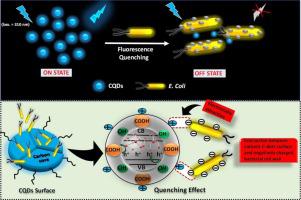Colloids and Surfaces B: Biointerfaces ( IF 5.4 ) Pub Date : 2020-09-01 , DOI: 10.1016/j.colsurfb.2020.111333 Manisha Kumari 1 , Savita Chaudhary 1

|
The reliable means for the quick recognition of pathogenic bacteria for disease prevention has acquired a considerable significance among researchers for human wellbeing. The purpose of current study is to fabricate highly photo-luminescent and biocompatible carbon dots (CQDs) from single used plastic waste such as poly bags, cups and bottles for selective sensing of E. coli. The formed small sized spherical CQDs have possessed high water solubility with excellent photo stable nature. The detailed fluorescence emission studies of CQDs have illustrated the overview of different types of surface defects and emissive states in formed particles. In addition, the specific role of prepared CQDs with bio-compatible nature has been thoroughly checked on hemolysis of red blood cells by employing in-vitro blood compatibility assay. A combination of anticoagulant and thrombolytic activity of CQDs with anti-oxidative activities from reactive oxygen species (ROS) generation were found to be responsible for the biocompatibility of formed CQDs. The effective in vitro stability toward histidine, cysteine, bovine serum albumin (BSA), human serum albumin (HSA) and saline supported the biocompatibility of formed particles as a function of different concentrations of CQDs. The optimized fluorescence properties with high surface to volume ratio of CQDs have provided a better alternative for “turn-off” fluorescence detection of E. coil in aqueous media with limit of detection down to 108 CFU/mL estimated by using standard colony-counting method. The as prepared nanosensor provided easy fabrication with fast response, high sensitivity and selectivity in real water samples which might be necessary for detecting pathogenic agents. In addition, the current work has provided the large overview in blood compatibility and anti-oxidative potential of prepared CQDs and giving useful information for preparing blood–compatible nanoparticles with enhanced bacterial discrimination ability.
中文翻译:

调节从塑料废料合成的碳点的物理化学和生物学特性,以有效检测大肠杆菌。
快速识别病原菌以预防疾病的可靠方法在研究人员的人类健康中已具有相当重要的意义。当前研究的目的是从一次性塑料废料(例如用于选择性检测大肠杆菌的塑料袋,杯子和瓶子)中制造出高度光致发光且具有生物相容性的碳点(CQD)。所形成的小尺寸球形CQD具有高水溶性,具有出色的光稳定性。对CQD的详细荧光发射研究已经阐明了所形成颗粒中不同类型的表面缺陷和发射态的概况。此外,已采用体外方法彻底检查了具有生物相容性的制备的CQD在红细胞溶血中的特定作用。血液相容性测定。CQD的抗凝和血栓溶解活性与活性氧(ROS)产生的抗氧化活性的结合被发现是所形成CQD的生物相容性的原因。对组氨酸,半胱氨酸,牛血清白蛋白(BSA),人血清白蛋白(HSA)和盐水的有效体外稳定性支持了所形成颗粒的生物相容性,这是不同浓度CQD的函数。具有高CQD表面积与体积比的优化荧光特性,为水性介质中大肠杆菌的“关闭”荧光检测提供了更好的替代方法,其检测限低至10 8使用标准菌落计数法估算的CFU / mL。所制备的纳米传感器在实际水样品中提供了易于制造的快速响应,高灵敏度和选择性的制造方法,这对于检测病原体可能是必需的。此外,当前的工作对制备的CQD的血液相容性和抗氧化潜力进行了全面概述,并为制备具有增强细菌区分能力的血液相容性纳米颗粒提供了有用的信息。











































 京公网安备 11010802027423号
京公网安备 11010802027423号